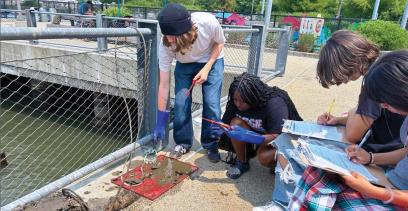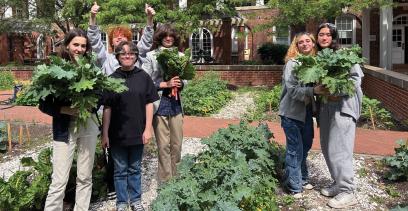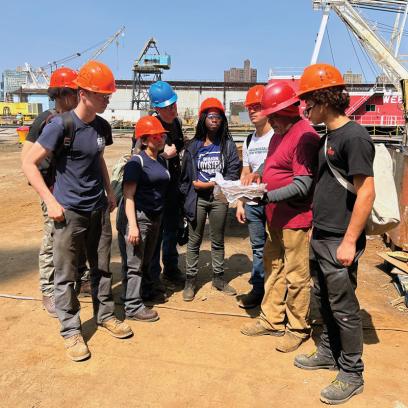Ever wondered how to become the captain of a ferry or the leader of a team of engineers designing robotic submarines? New York City’s Harbor School has answers for you. This unique school offers eight career pathways: aquaculture, marine biology research, marine affairs, marine systems technology, ocean engineering, professional diving, vessel operations, and welding and fabrication.
We spoke with three Harbor School teachers—Clarke Dennis, Rick Lee, and Robert Markuske—to learn about the school and how they help students develop a strong foundation for careers on and off the water. We’re particularly impressed with how they maintain close ties to industry professionals and keep tabs on job trends so they know they’re preparing students for growing careers.
–EDITORS
EDITORS: Tell us about the Harbor School.
RICK LEE: The Harbor School is a career and technical education (CTE) school designed to meet the growing demand for maritime-related careers through academics and hands-on learning. It is on Governors Island in New York Harbor—not far from the Statue of Liberty—and accessible only by ferry. We tailor our academic programs to themes and projects that are tangible for the students in this environment. Our mission is to develop awareness of the waterfront, the industries of the waterfront, the environmental impact of the waterfront, and the waterways and all of the commercial, environmental, and recreational functions of those waterways. Importantly, our enrollment is open to all high school students in New York City. We have more applicants than we do seats, so students are chosen by lottery. We also have eight different CTE programs, which is unusual. Much larger schools in New York City have fewer career tracks.
EDITORS: What led you to the Harbor School? What do you teach?
ROBERT MARKUSKE: I teach marine affairs. It’s a natural resource and management class with an environmental anthropology lens. We examine the human impact on the environment and try to solve complex problems through both policy and hands-on approaches. For example, my students are figuring out how to manage our food waste at the Harbor School and starting an urban farm to manage stormwater.
Prior to coming to the Harbor School, I was a park ranger on Governors Island, and I won a grant to manage a partnership between the Harbor School and the National Park Service to introduce students to national parks. Then, while I was working in a national park out west, the Harbor School asked me to come teach history. I took that position in 2012, and then a couple of years ago I was asked to transition into marine affairs. Prior to the park service, I did environmental policy and activism.
CLARKE DENNIS: I’ve been in the welding industry for 30 years. I’m a journeyman ironworker by trade but have done a lot of welding in other industries, including ship repair and scenery building for theaters. I was recruited to work with one of the school’s nonprofit partners, the Billion Oyster Project, in 2015. I ran an afterschool program for them two days a week for a couple of years, then became full-time with the school, teaching welding and fabrication as part of the marine systems technology career pathway.
RICK: I teach the ocean engineering course of study. I joined the Harbor School faculty as a math teacher in 2005 when it was just getting started. The school didn’t become a full-fledged CTE school until about a decade ago. Prior to that, there were a lot of shop classes, and some courses were aligned with career pathways. In those early days, I had an afterschool robotics program. Partnering with the Stevens Institute of Technology in Hoboken, New Jersey, we were building underwater robots. That soon became an elective class and was part of the school’s transition to having an ocean engineering career pathway.
Before I became a teacher, I was a lot of things: a metal worker in small fabrication shops, a commercial fisherman in southeast Alaska, and a freelance writer.
EDITORS: In the past, too many CTE programs were not designed to prepare students for higher learning and for jobs with opportunities to advance. How do you ensure you’re opening doors for students?
ROBERT: With my students, I have a three-pillar approach with a classroom component, a lab component, and a work-based learning experience. For our waste management project, I teach the science and impact of waste in our society and how waste is managed at the school. Students realize that it’s a problem because schools are inherently wasteful, so then they work with other stakeholders to make our school less wasteful. Currently, my students are figuring out how to make as much waste as possible into compost. Then they are using that compost in an urban farm that they’re developing. And since I’m teaching marine affairs, my students also write about what they’ve learned and done. Last fall, they wrote testimony and spoke at City Hall on behalf of citywide composting.
This multidisciplinary approach is inherently experiential but also grounded in and reinforced by academic skills. It prepares kids for both careers and college. Students from my program can move right into working for urban farms, compost organizations, or environmental nonprofits—or they can go to college to study environmental policy or further enhance their academic and hands-on experiences with an associate degree in natural resource management.
I try to make sure my students understand all aspects of what they’re doing. When they are planting on our urban farm, do they know the science behind what they’re planting? Do they know the reason behind what they’re planting? Is it a native plant? Is it what Indigenous people grew here? I think the Harbor School tries to make everything our students study multidisciplinary.
CLARKE: With welding and fabrication, we’re focused on postsecondary options. I’m a product of an apprenticeship. I worked full-time and was paid while learning at night. Now I’m working with unions and the building trades to prepare my students for apprenticeships—and I’m also working with colleges to develop articulation agreements to be sure our students are ready for their welding programs. We have an articulation agreement with City Tech here in New York, and in January I took a group of students to meet with the apprenticeship coordinator for the local ironworkers’ unions.
Our courses are not just hands-on. Students also learn about the different welding processes, safety, and literacy in terms of being able to read blueprints and welding symbols. These are online assignments that my students do, and then they earn industry-recognized credentials.
RICK: Internships are a big part of our coursework. All of our seniors have internships in the spring, and we try to arrange summer internships for students after 10th and 11th grades. I’ve had students intern with architects, with professionals who are designing circuit boards for satellites, and with those who are using 3-D manufacturing for rapid prototyping.
ROBERT: We do a lot of networking to find these summer and senior internships. We’re looking for workplace learning that draws on the content we teach, career trends in New York City, and students’ interests. I recently had students intern with the Brooklyn Children’s Museum, a compost facility, and an environmental nonprofit.
RICK: An important part of work-based learning is helping students research what careers align with their skills and interests. When I have students take career surveys early on, they’re given a list of matching careers and I ask, “How many of these do you actually know what they are?” Education helps, but experience is key. Students may not figure out what they want to do while in high school, but we can give them tools to keep exploring and doing career research.
ROBERT: Students also need to experience “a day in the life.” Some said, “Oh, I want to do scientific research.” After I arranged an internship, they saw the challenges of day-to-day work. Students spent a summer working with scientists in our estuary, looking at data and making presentations. It was hard work, and they needed to see this to reassess their interest moving forward. Sometimes kids come in with a very superficial, very glamorous view of what a career is. Our job is to not only gain their interest but also show them what it really is to be in that career.
EDITORS: If you think back a decade or so, what do you wish you had known? What have you learned that may be of use to educators ramping up their CTE pathways?
ROBERT: I want to highlight that it is an incredible amount of work because our programs are predicated on career outlooks and trends. The program I facilitate has changed because of the job market. A lot of my content and projects are now geared toward green careers and sustainability. We have to be educated ourselves, constantly watching where career opportunities are growing. The program is up for reevaluation every five years; although that’s a lot of work, I agree with that process because it ensures we regularly examine what we’re teaching. We’re teaching students to pursue careers, and if we’re teaching toward careers that are in decline or are oversaturated, we have to know that and change directions.
CLARKE: We’re trying to build an even more diverse group of advisors for our program to keep tabs on market trends. That’s one thing I would suggest to anybody who’s starting a CTE program: develop partners that are not just one- or two-dimensional. You need a broad look at career opportunities for your students.
Each CTE program at the Harbor School has a professional advisory committee of academic and industry partners; staying in touch with them is how we ensure we’re preparing students for good careers. I subscribe to several different industry magazines to stay ahead. Our school is a member of the American Welding Society, and I use its curriculum and test. We also have local connections to ironworkers, the shipbuilding and ship repair industry, and the theater industry (since welding and fabrication for sets is a big business in New York City).
I let students know that it’s good to diversify in terms of what kind of welding job they may be doing in the future—it could be anything from wind turbines to HVAC systems to skyscrapers. Once they become welders, they need to be flexible and jump from one industry to another as demand rises and falls.
ROBERT: I think something that you can hear in our answers is how important it is to go out in the community and see what is available. We find problems in communities and work with students on solving those problems, with a trade or career focus. For instance, Clarke and I are collaborating now. My students are trying to start a farm, but we had a problem with our irrigation system. My kids designed the irrigation system, and Clarke’s students will build the infrastructure.
RICK: Shifting gears a little, one of my lessons learned is to remember to step back. After the 9th grade survey of all of our career pathways, students select their pathway to focus on for grades 10–12. Coming into the 10th grade, do they really know that they want to be a welder, an urban farmer, or an engineer? Even if they stick with their plan A throughout high school, they may find out later it’s not what they want to do. We have to provide them with specific skills and credentials and make sure they have the knowledge and skills to be able to change their minds later. Fortunately, in their hands-on experiences our students learn many transferable skills, from safety on the job to how to collaborate with colleagues. Even though this is a CTE school, it’s also still a testing ground for our students—and it should be. They’re kids.
EDITORS: What are you excited about in your programs?
CLARKE: We are applying for a grant from the American Welding Society for about $25,000 to help with expanding our fume extraction so students can branch out into different kinds of metals. I’m hopeful that we’ll win this year—but I’ll keep applying until we do win.
We are also creating a more real-life work environment in our welding shop: each grade now has a crew chief (what was known as a foreman in the past). Students are learning to take orders and direction from another person around their age. At the moment, all three crew chiefs are female. They truly earned their positions, but I’m glad it has happened because it’s good in a traditionally male-driven industry for the male students to be comfortable taking orders from a female.
ROBERT: I am very excited that this interdisciplinary approach to solving complex problems with sustainability is becoming a trend. One thing on the horizon for us is that the marine affairs program and the aquaculture program are collaborating, along with a partner, on developing a controlled environmental agricultural certificate. It’s the epitome of solving a problem. We’re a city, and our natural resources are being depleted; hydroponics is a way of providing communities with food. Students will leave high school with the skills to be technicians in providing communities with sustainable produce options. I’m excited about that. In addition, students are working with several stakeholders on evaluating the coastal resiliency plan for Lower Manhattan; they are engaging with professionals from multiple fields to explore solutions from different perspectives. This is really opening up career exploration. If they can tie in composting, hydroponics, and advocacy in a future plan for Lower Manhattan resilience projects, that will be pioneering.
Our school has been selected to be a pilot for the New York City Public Schools’ Exploring Sustainability and Green Careers course. We have chosen a cohort of students from each of our CTE programs to learn the fundamentals of sustainability and then work with an outside organization to obtain solar installation training. Thereafter they will design and install solar panels for a drip irrigation system that uses rainwater. This embodies career exploration, training, and implementing solutions at a micro level on our campus.
RICK: I think the offshore wind industry will provide great opportunities that potentially impact all of our programs. There are marine biologists studying the effects of having wind turbines in the water. There are policymakers examining environmental impact studies to determine appropriate regulations. It cuts through all of us, which is awesome because it also allows students to have a direct, high-need training program. We’re working with the New York State Energy Research and Development Authority, which is a state agency working toward reducing greenhouse gas emissions and promoting economic growth. It’s providing money for offshore wind training.
Another great opportunity is that we received funding to become a P-TECH school; this is a nationwide model in which students earn industry-recognized associate degrees and gain work experience. It’s a natural extension of our current career pathways. We just had our first meeting in January, so there’s lots of planning ahead—but it’s an exciting development.
[Photos courtesy of the Harbor School]




